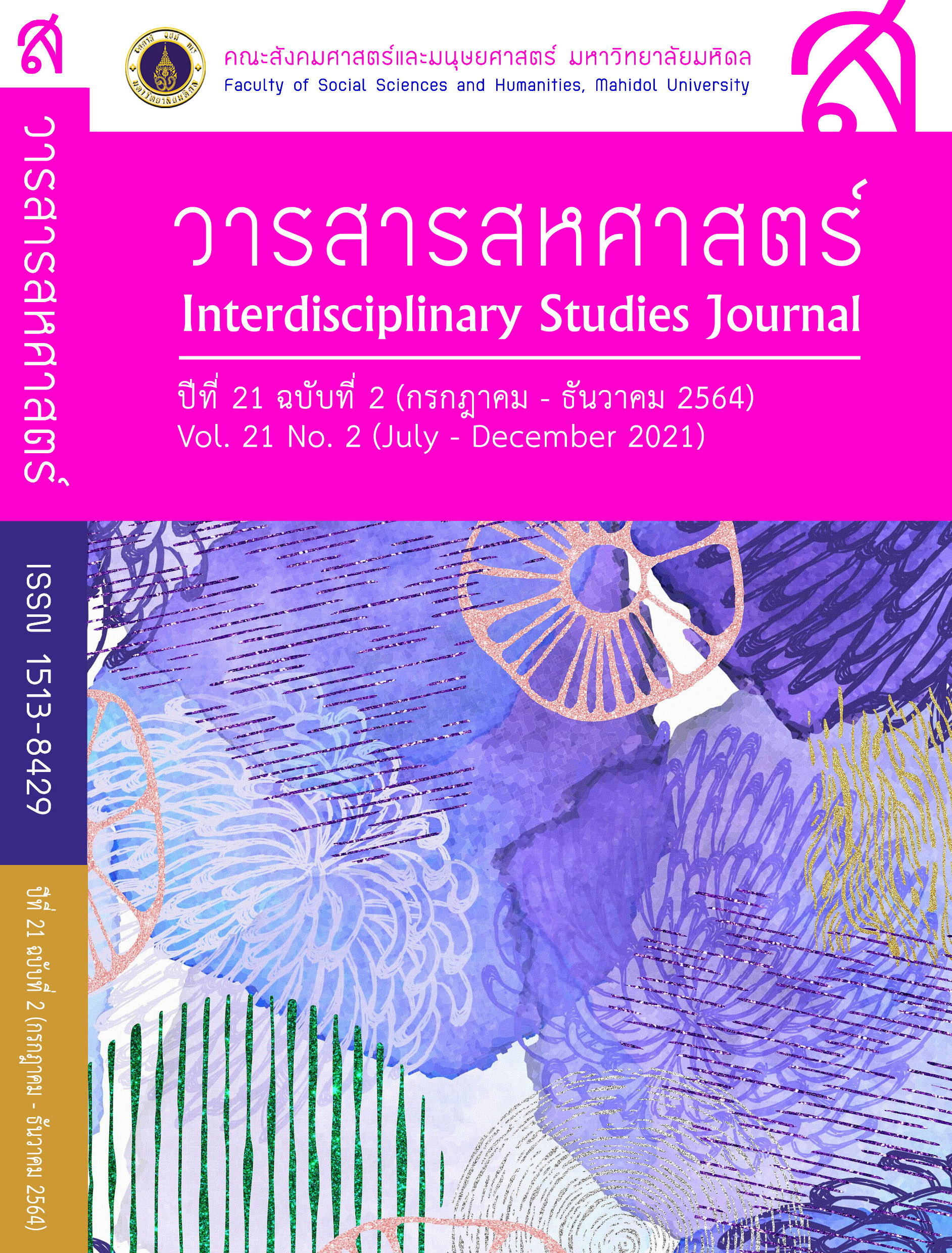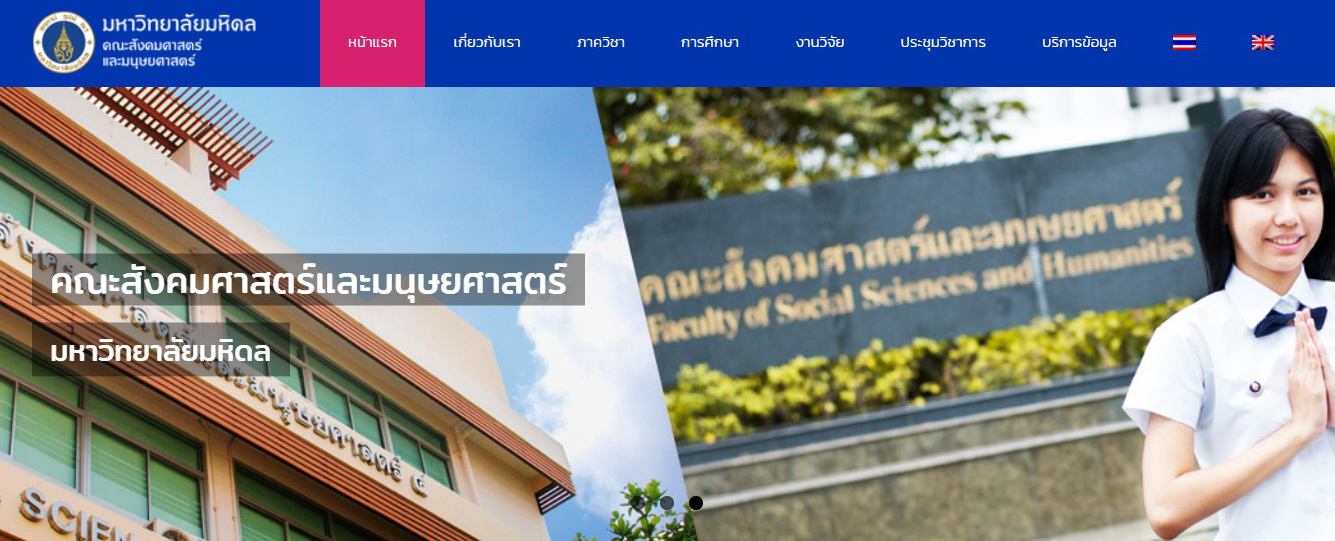การวิเคราะห์แผนแม่บทของแหล่งมรดกโลกในประเทศไทย: การวิจัยเชิงเอกสาร
คำสำคัญ:
Thailand, UNESCO heritage sites, heritage managementบทคัดย่อ
บทความนี้เป็นการอภิปรายเกี่ยวกับสถานที่ทางวัฒนธรรมขององค์การยูเนสโก (สุโขทัยและอยุธยา) ตามแผนแม่บททางประวัติศาสตร์และการท่องเที่ยว การอภิปรายกล่าวเป็นนัยว่าเหตุการณ์ทางประวัติศาสตร์และวัฒนธรรมกำหนดนโยบายมรดกโลกในช่วงต้นทศวรรษ 1960 จนถึงปัจจุบัน รวมทั้งได้กำหนดรูปแบบไว้ในแผนแม่บทมรดกและการท่องเที่ยวของสถานที่เหล่านั้น นโยบายเหล่านี้นำไปสู่การกำหนดลักษณะทางกายภาพของมรดกโลก (heritagescape) ตลอดจนร่วมกำหนดประเด็นด้านการศึกษาของแหล่งมรดกโลก นอกจากนั้นนโยบายการจัดการมรดกโลก หรือแผนแม่บทเป็นการกำหนดจากบนลงล่าง ได้มีการกำหนดอย่างมีนัยสำคัญถึงการไม่สนับสนุนการมีส่วนร่วมของชุมชนท้องถิ่นในการกำหนดชะตากรรมของพวกเขาเอง
เอกสารอ้างอิง
Askew, M. (2010). The magic list of global status. UNESCO, World Heritage and the agendas of states. In S. Labadi & C. Long (Eds.), Heritage and Globalisation Heritage and Globalisation (pp. 19-44). London and New York: Routledge.
Baker, C. J., & Pasuk, P. (2005). A history of Thailand. New York: Cambridge University Press.
Baker, C. J., & Pasuk, P. (2016). The palace law of Ayutthaya and the Thammasat : law and kingship in Siam.
Barmé, S. (1993). Luang Wichit Wathakan and the creation of a Thai identity. Singapore: Institute of Southeast Asian Studies.
Byrne, D. (1995). Buddhist Stupa and Thai social practice. World Archaeology, 27(2), 266-281.
Byrne, D. (2014). Counterheritage. Critical perspectives on heritage conservation in Asia (5). New York and London: Routledge.
(Ed.). (1991). The Ram Khamhaeng controversy. Bangkok: Siam Society.
Chapman, W. (2013). A Heritage of ruins. Honolulu: University of Hawaii Press.
Charoenwongsa, P. (1987). Moradok Ban Chiang/The legacy of Ban Chiang. Bangkok: Krom Sinlapakon.
Charoenwongsa, P. (1995). Authenticity: does it really matter much? In K. E. Larsen (Ed.), Nara Conference on Authenticity. Conference de Nara sur l’Authenticité (pp. 287-291). Trondheim: Tapir.
Chulalongkorn University Social Research Institute. (1984). Master plan for tourism development in Phitsanulok, Kamphaeng Phet, Sukhothai, Tak, Pichit. Bangkok: Tourism Authority of Thailand.
Chulalongkorn University Social Research Institute. (1988). Master plan for tourism development of Phra Nakhon Si Ayutthaya and the neighbouring provinces. Final report. Bangkok: Tourism Authority of Thailand.
Cleere, H. (1995). The Evaluation of Authenticity in the Context of the World Heritage Convention. In K. E. Larsen (Ed.), Nara Conference on Authenticity. Conference de Nara sur l’Authenticité (pp. 57-66). Trondheim: Tapir.
Colwell, C., & Joy, C. (2015). Communities and Ethics in the Heritage Debates. In L. Meskell (Ed.), Global Heritage: A Reader (Wiley Blackwell Readers in Anthropology) (1 ed., pp. 112-130). Wiley-Blackwell.
Connors, M. K. (2005). Ministering Culture. Hegemony and the Politics of Culture and Identity in Thailand Hegemony and the Politics of Culture and Indentity in Thailand. Critical Asian Studies, 37(4), 523-551.
Cushman, R. D. (2006). The Royal Chronicles of Ayutthaya. Bangkok: The Siam Society.
Di Giovine, M. A. (2009). The heritage-scape. Lanham: Lexington Books.
du Cros, H., & McKercher, B. (2014). Cultural tourism. London and New York: Routledge.
Fine Arts Department. (1982). Sukhothai Historical Park development project master plan. Paris: UNESCO.
Fine Arts Department. (1997). Pam-Maebot Klongkam Anurak Lae Pattana Nakorn-Prawatsasrt Pra Na Kom Sri Ayutthaya (Master Plan for the conservation and developmental project for Ayutthaya Historical City). Bangkok: San Rangsan.
Gosling, B. (1998). A Chronology of Religious Architecture at Sukhothai. Chiang Mai: Silkworm Books.
Gozzoli, R. B. (2016). Ambiguities of Heritage. Ayutthaya Historical Park, Thailand. In V. T. King (Ed.), UNESCO in Southeast Asia. World Heritage Sites in Comparative Perspective (pp. 169-198). Copenhagen: NIAS Press.
ICOMOS. (1992). Advisory Board Evaluation. World Heritage List no. 575: Ban Chiang. Retrieved 10 January, 2019 from https://whc.unesco.org/document/153797
Ishizawa, Y., Kono, Y., & Rojpojchanarat, V. (Eds.). (1988). Study on Sukhothai (Vol. 3). Tokyo: Institute of Asia Cultures, Sophia University.
Ito, N., & Larsen, K. E. (1995). “Authenticity” Inherent in Cultural Heritage in Asia and Japan. In K. E. Larsen (Ed.), Nara Conference on Authenticity. Conference de Nara sur l’Authenticité (The paper discusses the problems inherent with wooden material used in heritage buildings in Asia in general. As the material gets easily damaged by humidity, it needs to be changed quite often. ed., pp. 35-45). Trondheim: Tapir.
Jumsai, S. (2013). A Record of Historical Conservation, 1964-2012. In C. J. Baker (Ed.), Protecting Siam’s Heritage (pp. 41-54). Chiang Mai: Silkworm Books.
Keyes, C. F. (2002). The Case of the Purloined Lintel: The Politics of a Khmer Shrine as a Thai National Treasure. In C. J. Reynolds (Ed.), National identity and its defenders: Thailand today (pp. 212-237). Chiang Mai; Thailand: Silkworm Books.
King, V. T., & Parnwell, M. J. G. (2011). World Heritage Sites and domestic tourism in Thailand. South East Asia Research, 19(3), 381-420.
Krairiksh, P. (1991). The Date of the Ram Khamhaeng Inscription. In J. R. Chamberlain (Ed.), The Ram Khamhaeng Controversy (pp. 257-272). Bangkok: Siam Society.
Krairiksh, P. (2013). A Brief History of Heritage Protection in Thailand. In C. J. Baker (Ed.), Protecting Siam’s Heritage (pp. 15-40). Chiang Mai: Silkworm Books.
Labadi, S. (2013). UNESCO, cultural heritage, and Outstanding Universal Value. Lanham, MD: AltaMira Press.
Lee, E. (2009). World Heritage SIte Status: boon or bane? SPAFA Journal, 19(2), 15-28.
Lowenthal, D. (1985). The Past is a Foreign Country. Cambridge: Cambridge University Press.
Musigakama, N. (1988). The implementation of the Sukhothai Historical Park. In Y. Ishizawa, Y. Kono, & V. Rojpojchanarat (Eds.), Study on Sukhothai (Vol. 6, pp. 103-123). Tokyo: Institute of Asia Cultures, Sophia University.
Ndoro, W., & Wijesuriya, G. (2015). Heritage Management and Conservation: From Colonization to Globalization. In L. Meskell (Ed.), Global Heritage: A Reader (1 ed., pp. 131-149). Wiley-Blackwell.
NESDB. (1977). The Fourth National Economic and Social Development Plan (1977-1981).
Peleggi, M. (1996). National heritage and global tourism in Thailand. Annals of Tourism Research, 23(2), 432-448.
Peleggi, M. (2002). The politics of ruins and the business of nostalgia. Bangkok: White Lotus Press.
Peleggi, M. (2004). Royal Antiquarianism, European Orientalism and the Production of Archaeological Knowledge in Modern Siam. In S. Ravi (Ed.), Asia in Europe, Europe in Asia (pp. 133-161). Leiden and Singapore: International Institute for Asian Studies Institute of Southeast Asian Studies.
Peleggi, M. (2013). From Buddhist Icons to National Antiquities: Cultural Nationalism and Colonial Knowledge in the Making of Thailand’s History of Art Modern Asian Studies. Modern Asian Studies, 47(05), 1520-1548. doi:10.1017/S0026749X12000224
Peleggi, M. (2015). The Plot of Thai Art History. In M. Peleggi (Ed.), A Sarong for Clio. Essays on the Intellectual and Cultural History of Thailand Inspired by Craig J. Reynolds (1 ed., pp. 79-93). New York: Southeast Asia Program Publications.
Peleggi, M. (2016). Thai Kingdom. In The Encyclopedia of Empire (pp. 1-11). John Wiley & Sons, Ltd. doi:10.1002/9781118455074.wbeoe195
Phra Ratchaniphom Phrabat Somdet Phra Mongkhut Klaochaoyoohua. (1983). Tiau Muang Phra Ruang. Bangkok: Suksapanpanit.
Pichard, P. (1980). The Conservation of the monument of Sukhothai, Sri Satchanalai and Kamphaeng Phet: Thailand.
Rajanubnab, D. (2001). The chronicle of our wars with the Burmese. Bangkok; Thailand: White Lotus. Retrieved from http://www.worldcat.org/oclc/46429866
Rajanubnab, D. (2008). A Biography of King Naresuan the Great. Bangkok: Toyota Thailand Foundation.
Ramakien. (2538). Čhittakam fāphanang rū̜ang Rāmmakīan rō̜p phrarabīang Wat Phrasrīrattanasātsadārām. [Krungthēp]: Samnakngān Salāk Kinbæng Ratthabān.
Reynolds, C. J. (2006). Seditious Histories. Seattle and London: University of Washington Press in association with Singapore University Press.
Salazar, N. B., & Zhu, Y. (2015). Heritage and tourism. In L. Meskell (Ed.), Global Heritage: A Reader (1 ed., pp. 240-258). Chichester and Malden: Wiley-Blackwell.
Sattayanurak, S. (2002). Intellectuals and the Establishment of Identities in the Thai Absolute Monarchy State. JSS, 90(1&2), 101-124.
Smith, L. (2006). Uses of heritage. London: Routledge.
Terwiel, B. J. (2011a). Thailand’s political history: from the 13th century to recent times. Bangkok: River Books.
Terwiel, B. J. (2010). The Ram Khamhaeng inscription (5). Gossenberg: Ostasien Verlag.
Terwiel, B. J. (2011b). Using Ockham’s Razor with Respect to the Ram Khamhaeng Controversy. In V. Grabowski (Ed.), Southeast Asia Historiography. Unravelling the Myths (pp. 42-51). Bangkok: River Books.
Timothy, D. J., & Boyd, S. W. (2003). Heritage tourism. Harlow: Prentice Hall.
UNESCO World Heritage Committee. (1977). Operational Guidelines for the World Heritage Commitee. Retrieved from http://whc.unesco.org/archive/opguide77a.pdf
UNWTO. (2016). Tourism Development Master Plans and Strategic Development Plans. Retrieved 10/04/2016, from http://cooperation.unwto.org/technical-product/tourism-development-master-plans-and-strategic-development-plans
Veeravong, S., & Pongsapich, A. (2000). Dynamics of Ayutthaya region. Bangkok.
Vella, W. F. (1978). Chaiyo! King Vajiravudh and the Development of Thai Nationalism. Honolulu: The University Press of Hawaii.
Wongthes, M. (2003). Intellectual Might and National Myth. A Forensic Investigation of the Ram Khamhaeng Controversy in Thai society. Bangkok: Matichon.
Woodward, H. W. (2015). Bangkok Kingship: The Role of Sukhothai. Journal of the Siam Society, 103, 183-197.

ดาวน์โหลด
เผยแพร่แล้ว
รูปแบบการอ้างอิง
ฉบับ
ประเภทบทความ
สัญญาอนุญาต
ลิขสิทธิ์ (c) 2022 Pattarachit Choompol Gozzoli

อนุญาตภายใต้เงื่อนไข Creative Commons Attribution-NonCommercial-NoDerivatives 4.0 International License.
สหศาสตร์: วารสารสังคมศาสตร์และมนุษยศาสตร์ ให้ความสำคัญกับการคุ้มครองลิขสิทธิ์และสิทธิของผู้นิพนธ์ในการเผยแพร่ผลงานวิชาการ โดยมีวัตถุประสงค์เพื่อส่งเสริมความโปร่งใส ความถูกต้องตามหลักวิชาการ และสอดคล้องกับแนวปฏิบัติสากล ทั้งนี้ วารสารกำหนดนโยบายดังต่อไปนี้
|
1. การยอมรับเงื่อนไขการเผยแพร่ - ผู้นิพนธ์ที่ส่งบทความเพื่อตีพิมพ์ ต้องปฏิบัติตามนโยบายและเงื่อนไขการเผยแพร่ของวารสารโดยเคร่งครัด - การส่งบทความถือเป็นการยอมรับให้นำบทความเข้าสู่กระบวนการพิจารณาและการเผยแพร่ตามมาตรฐานของวารสาร |
|
2. การโอนลิขสิทธิ์ - เมื่อบทความได้รับการตอบรับเพื่อตีพิมพ์ ผู้เขียนโอนลิขสิทธิ์ของบทความให้แก่วารสาร - วารสารมีสิทธิ์เผยแพร่ ทำซ้ำ และเผยแพร่บทความในทุกรูปแบบ ทั้งสิ่งพิมพ์ เว็บไซต์ และสื่อออนไลน์อื่น ๆ |
|
3. สิทธิ์ของผู้นิพนธ์หลังการโอนลิขสิทธิ์ - ผู้นิพนธ์ยังคงมีสิทธิ์ใช้บทความเพื่อวัตถุประสงค์ทางวิชาการ เช่น การสอน การวิจัยส่วนบุคคล การใช้ประกอบวิทยานิพนธ์ หรือการเผยแพร่ในแพลตฟอร์มที่ไม่ใช่เชิงพาณิชย์ - การนำบทความไปใช้เพื่อวัตถุประสงค์เชิงพาณิชย์ ต้องได้รับอนุญาตจากวารสารก่อนเป็นลายลักษณ์อักษร |
|
4. การเผยแพร่ภายใต้สัญญาอนุญาตสาธารณะ (Creative Commons License) - บทความทั้งหมดในวารสารจะเผยแพร่ภายใต้สัญญาอนุญาต Creative Commons Attribution-NonCommercial-NoDerivatives 4.0 International (CC BY-NC-ND 4.0) - บุคคลอื่นสามารถเผยแพร่หรือแบ่งปันบทความได้โดยต้องให้เครดิตแก่ผู้นิพนธ์ต้นฉบับ แต่ห้ามแก้ไข ดัดแปลง หรือใช้ในเชิงพาณิชย์ |
|
5. ความถูกต้องของเนื้อหาและการใช้สื่อจากบุคคลที่สาม - ผู้เขียนต้องรับรองว่าบทความที่ส่งเพื่อตีพิมพ์เป็นผลงานต้นฉบับของตนเอง ไม่ได้ส่งซ้ำซ้อน (duplicate submission) และไม่ละเมิดลิขสิทธิ์หรือคัดลอกผลงานของผู้อื่น รวมถึงไม่มีการปลอมแปลงข้อมูล การตีพิมพ์ซ้ำ หรือการกระทำใด ๆ ที่ขัดต่อหลักจริยธรรมทางวิชาการ - ผู้เขียนต้องรับผิดชอบในการขออนุญาตใช้สื่อจากบุคคลที่สาม เช่น ภาพ ตาราง หรือกราฟิก และต้องอ้างอิงหรือให้เครดิตอย่างถูกต้องน |
|
6. ข้อจำกัดความรับผิดชอบ (Disclaimer) - บทความที่ได้รับการตีพิมพ์ในวารสารสหศาสตร์: วารสารสังคมศาสตร์และมนุษยศาสตร์ถือเป็นลิขสิทธิ์ของวารสาร - ข้อความ ข้อมูล และข้อคิดเห็นที่ปรากฏในบทความเป็นความรับผิดชอบของผู้เขียนแต่ละท่านโดยตรง มิได้สะท้อนถึงทัศนะหรือจุดยืนของกองบรรณาธิการหรือหน่วยงานที่เกี่ยวข้อง - หากบทความมีข้อผิดพลาดหรือการละเมิดสิทธิ์ใด ๆ ความรับผิดชอบทั้งหมดเป็นของผู้เขียนแต่เพียงผู้เดียว - การนำบทความไปใช้ในเชิงพาณิชย์ ต้องได้รับอนุญาตเป็นลายลักษณ์อักษรจากบรรณาธิการวารสารก่อน ทั้งนี้ ผู้ขออนุญาตต้องจัดทำคำชี้แจงเกี่ยวกับวัตถุประสงค์และลักษณะการใช้งานอย่างชัดเจน การใช้บทความในเชิงพาณิชย์โดยไม่ได้รับอนุญาตถือเป็นความรับผิดชอบของผู้ใช้แต่เพียงผู้เดียว |




